- Home
- Gore Vidal
The Last Empire Page 6
The Last Empire Read online
Page 6
The literary world before 1914 is now as distant from us as that of Richardson and Fielding. In those days novels and short stories were popular entertainment. They were meant to be read by just about everybody. Numerous magazines published thousands of short stories of every kind, and a busy minor writer could make as good a living as a minor bank president. Writing was simply a trade that, sometimes, mysteriously, proved to be an art. William Dean Howells had balanced commerce and art with such exquisite tact that he was invaluable as editor and friend to both the Paleface Henry James and the Redskin Mark Twain. Howells himself was a very fine novelist. But he lived too long. For the rising generation of the new twentieth century, he was too genteel, too optimistic (they had carelessly misread him); too much Beacon Street not to mention London and Paris and the Russia of Dostoevsky, whose first translations Howells had brought to the attention of those very conventional ladies who were thought to be the principal audience for the novel in America.
While still at Yale, Lewis headed straight to the action. Upton Sinclair had started a sort of commune, Helicon Hall, at Englewood, New Jersey, and in 1906 Lewis spent two months there, firing furnaces and writing. By 1909 he was at Carmel with his classmate William Rose Benét, another professional bookman. Lewis worked on the San Francisco Bulletin, and wrote. When Jack London had come to Yale to speak for socialism, Lewis had met him. Although Lewis was to be, briefly, a card-carrying Socialist, he was never much interested in politics, but he very much admired the great Redskin writer, and he got to know him at Carmel.
London wrote short stories for a living. Unfortunately, he had trouble thinking up plots. Although Lewis was not yet making a living from short stories, he had thought up a great many plots. So, in 1910, Lewis sold Jack London fourteen short story plots for $70. Two became published short stories; the third the start of a not-to-be-finished novel. Lewis later described London at that time as someone more interested in playing bridge than sea-wolfing. He also described how “Jack picked up James’s The Wings of the Dove . . . and read aloud in a bewildered way. . . . It was the clash between Main Street and Beacon Street that is eternal in American culture.” Well, eternity is a long time in bookchat land.
In 1910 Lewis moved on to Washington, D.C., which was to become, more or less, his home base in the United States. Meanwhile he worked for New York publishers as reader, copywriter, salesman. He was also selling fiction to the flagship of commercial publishing, The Saturday Evening Post, as well as to other magazines. From 1913 to 1914 he produced a syndicated book page that was carried in newspapers all around the country. By putting himself at the center of bookchat, he ensured good reviews for his own books in much the same way that in England now ambitious young writers not only review each other’s books but also often act as literary editors in order to promote their future reviewers. Those destined for greatness will eventually review television programs in a Sunday newspaper, thus getting to know the television and film magnates who will, in due course, promote them personally on television as well as buy their products for dramatization. The English literary scene today is like that of the United States pre-1914.
Lewis’s first novel, Our Mr. Wrenn, is very much school of Wells; it was, of course, well reviewed by his fellow bookmen. In the next four years Lewis published four more novels. Each had a subject, of which the most interesting was early aviation, The Trail of the Hawk (1915). Lewis had got to know Paul Beck, one of the first army fliers, and the novel presages, rather eerily, Lindbergh’s career. In my memory these books are rather like those of Horatio Alger that I was reading at the same time, something of an agreeable blur. Since the Subject comes before the Characters and since Lewis was a thorough researcher, there are many little facts of the sort that pop writers today provide as they take us on tours of the cosmetics or munitions businesses, subjects they usually know very little about beyond idle, as opposed to dogged, research. Only James Michener, through hard work, has mastered the fictional narrative as a means of instruction in a subject of interest to him, like Hawaii; and then to millions of others.
The first five novels established Sinclair Lewis as a serious if not particularly brilliant novelist; but one with, as they say at Billboard, a bullet. As a careerist, Lewis was an Attila. In his pursuit of blurbs, he took no prisoners. He cultivated famous writers. Main Street is dedicated to James Branch Cabell and Joseph Hergesheimer, the two classiest novelists of the day. Babbitt is dedicated to Edith Wharton, who took it all in her magnificent ruthless stride.
In 1915 his old mentor Upton Sinclair was invited to assess the product. He did:
You seem to me one of the most curiously uneven writers I have ever known. You will write pages and pages of interesting stuff, and then you will write a lot of conversation which is just absolute waste, without any point or worthwhileness at all; and you don’t seem to know the difference. Everything of yours that I have read is about half and half . . . whenever you are writing about the underworld, you are at your best, and when you come up to your own social level or higher, you are no good.
Nicely, Upton Sinclair adds a postscript: “Don’t be cross.” Writers usually get other writers’ numbers rather more quickly than critics ever do. After all, as contemporaries, they have been dealt much the same cards to play with.
By 1929, the apprenticeship of Sinclair Lewis was over. He had married and become the father of a son, Wells, named for H.G., whom he had yet to meet (Lewis was deeply irritated when people thought that he had been named for Upton Sinclair when his father had named him after one Harry Sinclair, a dentist of the first rank).
The genesis of Lewis’s ascent can be located in the year 1916 when he and his wife, Grace, came to stay in Sauk Centre with Dr. Lewis and his wife, Sinclair’s stepmother. In her memoir, Grace Hegger Lewis is very funny about what must have been a fairly uncomfortable visit. “One morning when ‘the curse’ was upon me,” Grace asked for breakfast on a tray. The Lewises said no, while Hal, Grace’s name for her husband, was “furious. He had always taken for granted his affection for his parents and their behavior he had never questioned. But seeing his family through the eyes of New York and of marriage he was appalled by his father’s overbearing rudeness.” Grace suggests that this visit forced Lewis to see his hometown in an entirely new way and shift the point of view from that of a lonely offbeat lawyer in what was to be called The Village Virus, to that of Carol, a girl from outside the village who marries the local doctor, Will Kennicott, and so observes the scene with big city (in her case Minneapolis) eyes.
Grace reports that Dr. Lewis did apologize; the young couple stayed on; and the town magnates were brought to their knees when they learned just how much Lewis had been paid for a two-part serial in the Woman’s Home Companion ($1,500). “When he told them that it had taken him two weeks to write the serial, the banker, dividing so much per diem, was visibly awed. . . . The young Lewises were to find that this measuring of talent by dollars was fairly universal, and Hal was hurt at first by the lack of interest in the writing itself.”
Their later life in Washington sounds agreeable. She tells us how they would walk to the Chevy Chase Club with the young Dean Achesons and how Lewis also frequented the Cosmos Club and got to know General Billy Mitchell, Clarence Darrow, and the scarlet lady of our town, Elinor Wylie—murmur her name, as indeed people were still doing a few years later when I was growing up. The Lewises seem not to have known the Achesons’ friend Grace Zaring Stone, author of The Bitter Tea of General Yen, who, when told by a lady novelist that she was writing a novel about Evil, sighed, “If only I had thought of that!”
Lewis maintained that the idea for a novel whose subject would be a small Midwestern market town came to him in 1905. I should suspect that it was always there. Village life was the first thing that he had known and, sooner or later, writers usually deal with their origins. The real-life lawyer Charles T. Dorion was to be the main character, an idealistic soul, able to see through the pretences, the hypocrisies, th
e . . . the . . . the absolute boredom of Sauk Centre (renamed by Lewis Gopher Prairie). But the 1916 homecoming gave Lewis a new point of view, that of his elegant New York wife, to be called Carol. Dorion was demoted to supporting cast, as Guy Pollock.
In July 1920, in a Washington heat wave, Sinclair Lewis finished Main Street. He gave the book to his friend Alfred Harcourt, who had started a new publishing house to be known, in time, as Harcourt, Brace, in which Lewis had invested some of his own money. In the business of authorship he seldom put a foot wrong.
October 23, 1920, Main Street was published and, as one critic put it, “if Main Street lives, it will probably be not as a novel but as an incident in American life.” Even Schorer, not yet halfway through Lewis’s career, concedes, a bit sadly, that the book was “the most sensational event in twentieth-century American publishing history.” As of 1922 an estimated two million Americans had read the book; and they went right on reading it for years. With Howells gone, Lewis took his place as numero uno and reigned both at home and abroad until 1930, after which, according to Schorer, “with the increasing conformity at the surface of American life and the increasing fragmentation at its base, there have been no contenders at all.” I’m not sure that Bill or Ernest or Scott or Saul or Norman or . . . would agree. The contenders are all in place. The problem is that fiction—stories intended to be read by almost everyone—ceased to be of much interest to a public “with no time to read” and movies to go to and, later, television to watch. The Saturday Evening Post serial, often well-written by a good writer, would now be done, first, as a miniseries on television or as a theatrical film. Today nonfiction (that is, fictions about actual people) stuffs our magazines and dominates best-seller lists.
In any case, pace Schorer, conformity in American life, whatever that means, would certainly be a spur to any writer. As for fragmentation, it is no worse now as the countryside fills up with Hispanics and Asians as it was when Lewis was describing the American hinterland full of Socialist Swedes and comic-dialect Germans. Actually, to read about the career of Sinclair Lewis is to read about what was a golden age for writing and reading; now gone for good.
Lewis’s energetic self-promotion among the masters of the day paid off. His dedicatees Cabell and Hergesheimer wrote glowing testimonials. Predictably, the novel appealed to the English realists if not to Bloomsbury. The former wrote him fan letters—John Galsworthy, H. G. Wells, Rebecca West; presently he would be taken up by the monarch of bookchat and the master of the fact-filled realistic novel, Arnold Bennett. At home a fellow Minnesotan wrote him “with the utmost admiration,” F. Scott Fitzgerald. But five years later Fitzgerald is wondering if Arrowsmith is really any good. “I imagine that mine [Gatsby] is infinitely better.” Sherwood Anderson leapt on and off the bandwagon. Dreiser ignored the phenomenon but his friend H. L. Mencken was delighted with Lewis, and praised him in Smart Set. When Lewis’s sometime model Edith Wharton won the Pulitzer Prize for The Age of Innocence, Lewis wrote to congratulate her. As for this uncharacteristic lapse on the part of a committee designed to execute, with stern impartiality, Gresham’s Law, Mrs. Wharton responded with her usual finely wrought irony: “When I discovered that I was being rewarded by one of our leading Universities—for uplifting American morals, I confess I did despair.” She praises Lewis vaguely; later, she is to prove to be his shrewdest critic.
While Mr. and Mrs. Sinclair Lewis toured restlessly about Europe, trying to enjoy his success, he was already at work on Babbitt.
* The Library of America has now brought out both Main Street and Babbitt in a single volume, and it was with some unease that I stepped into the time-warp that is created when one returns after a half century not only to books that one had once lived in but almost to that place in time and space where one had read the old book—once upon a time in every sense. It was said of Lewis that, as a pre–1914 writer, he had little in common with the rising generation of post–World War writers like Hemingway, Dos Passos, Faulkner. It might equally be said that those of us who grew up in the Thirties and in the Second War made as great a break with what had gone before as today’s theoreticians made with us. Literary history is hardly an ascending spiral, one masterpiece giving birth to an even greater one, and so on. Rather there are occasional clusters that occur at odd intervals each isolated from the others by, no doubt, protocreative dust. Lewis was pretty much his own small star set to one side of Twain, Crane, James, and Wharton, and the small but intense postwar galaxy which still gives forth radio signals from that black hole where all things end. In the Twenties, only Dreiser was plainly Lewis’s superior but Dreiser’s reputation was always in or under some shadow and even now his greatness is not properly grasped by the few who care about such things.
What strikes one first about Main Street is the energy of the writing. There is a Balzacian force to the descriptions of people and places, firmly set in the everyday. The story—well, for a man who supported himself by writing stories for popular magazines and selling plots to Albert Payson Terhune as well as Jack London, there is no plot at all to Main Street. Things just happen as they appear to do in life. In Minneapolis, Carol Milford meets Will Kennicott, a doctor from the small town of Gopher Prairie. There are events, some more dramatic than others, but the main character is Main Street and the intense descriptions of the place are most effective, while the people themselves tend to be so many competing arias, rendered by a superb mimic usually under control. Later, Lewis would succumb to his voices and become tedious, but in Main Street he is master of what Bakhtin (apropos Dostoevsky) called “the polyphonic novel. . . . There is a plurality of voices inner and outer, and they retain ‘their unmergedness.’ ” Lewis is splendid on the outer voices but he lacks an idiosyncratic inner voice—he is simply a straightforward narrator without much irony—while his attempts to replicate the inner voices of the characters are no different, no more revelatory, than what they themselves say aloud.
“On a hill by the Mississippi where Chippewas camped two generations ago, a girl stood in relief against the cornflower blue of Northern sky.” The first sentence is brisk; it places us in time—reminds us that this was Indian territory a half century ago, and so the white man is new to the scene, and his towns are still raw. “Cornflower” is Saturday Evening Post. “Corn” itself is a bit dangerous, as in corny. “Blue” isn’t all that good either. Yet, paradoxically, Lewis had a lifelong hatred of the cliché in prose as well as a passion for sending up clichés in dialogue: this can cause confusion.
Anyway, he has now begun the story of Carol Milford, enrolled at Blodgett College, a girl full of dreams even more vivid than those of Emma Bovary—dreams rather closer to those of Walter Mitty than to Flaubert’s Emma, though, in practice, as it later proves, Carol has more than a touch of Bouvard and Pécuchet in her when she takes to the field with one of her projects to bring beauty to a drab world. Lewis maintained that, as of 1920, he had read neither Madame Bovary nor Edgar Lee Masters’s Spoon River Anthology, whose set of arias from the simple dead folk of a small-town cemetery inspired a generation of writers, achieving a peak, as it were, in Thornton Wilder’s Our Town. Incidentally, there is some evidence that Lewis based her on the mother of Charles Lindbergh (cf. 132).
Carol is involved in the “tense stalking of a thing called General Culture.” Ostensibly on her behalf, Lewis drops Culture names all over the place. First, Robert G. Ingersoll, the nineteenth-century agnostic, and then Darwin, Voltaire. One can’t really imagine her liking any of them—she is too romantic; she dreams of truth and beauty. Ingersoll is a hard-bitten, dour freethinker. The other two are outside her interest. Later he tells us that she has read Balzac and Rabelais. Since she becomes a librarian, the Balzac would be inevitable but neither Carol nor Sinclair Lewis ever read Rabelais. There are some things that an experienced dispenser of bookchat knows without any evidence.
At a Minneapolis party, Carol meets Dr. Will Kennicott, a doctor in the small town of Gopher Prairie. He is agreeabl
e, and manly, and adores her. In a short time: “He had grown from a sketched-in stranger to a friend.” Will is “sincere” (a favorite word of Carol’s is “insincere”). Carol meanwhile (as a result of Mrs. Wharton on interior decoration and Italian Gardens?) has dreamed that “what I’ll do after college [is] get my hands on one of those prairie towns and make it beautiful. Be an inspiration. I suppose I’d better become a teacher then. . . . I’ll make ’em put in a village green, and darling cottages, and a quaint Main Street!” Hubris is back in town. One doubts if the worldly Grace Hegger Lewis ever thought along those lines in Sauk Center in 1916. But Lewis has got himself a nice premise, with vast comic potentialities. But instead of playing it for laughs and making satire, he plays it absolutely straight and so achieved total popularity. Irony.
In 1912 Carol and Will get married. They take the train to Gopher Prairie. It is all very much worse than she expected. But Will exults in town and people. Although Lewis is noted for his voices, the best of the novel is the description of things and the author’s observations of the people who dwell among the things.
The train was entering town. The houses on the outskirts were dusky old red mansions with wooden frills, or gaunt frame shelters like grocery boxes, or new bungalows with concrete foundations, imitating stone. Now the train was passing the elevator, the grim storage-tanks for oil, a creamery, a lumber-yard, a stock-yard muddy and trampled and stinking.
They are met by Will’s friends, the elite of the village. There is a lot of kidding. Mock insults. Ho-ho-ho.
Main Street with its two-story brick shops, its story-and-a-half wooden residences, its muddy expanse from concrete walk to walk, its huddle of Fords and lumberwagons, was too small to absorb her. The broad, straight, unenticing gashes of the streets let in the grasping prairie on every side. She realized the vastness and emptiness of the land.

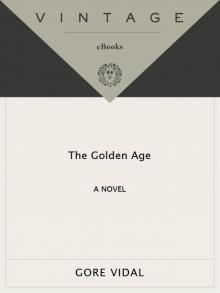 The Golden Age: A Novel
The Golden Age: A Novel Death Before Bedtime
Death Before Bedtime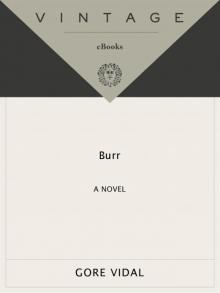 Burr
Burr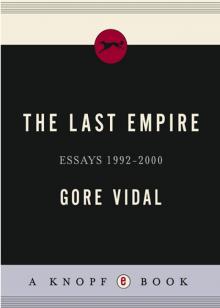 The Last Empire
The Last Empire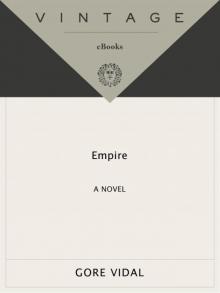 Empire: A Novel
Empire: A Novel The Selected Essays of Gore Vidal
The Selected Essays of Gore Vidal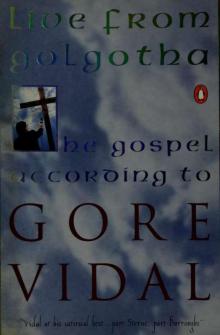 Live From Golgotha
Live From Golgotha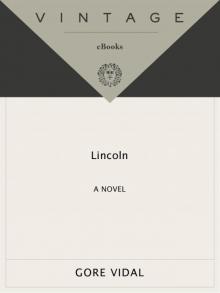 Lincoln
Lincoln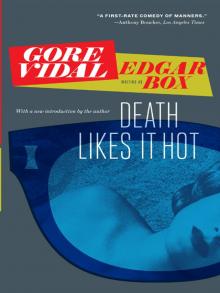 Death Likes It Hot
Death Likes It Hot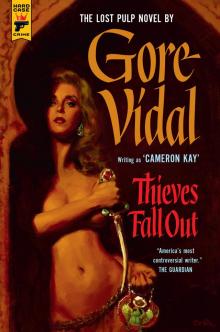 Thieves Fall Out (Hard Case Crime)
Thieves Fall Out (Hard Case Crime) Point to Point Navigation
Point to Point Navigation Williwaw
Williwaw Death in the Fifth Position
Death in the Fifth Position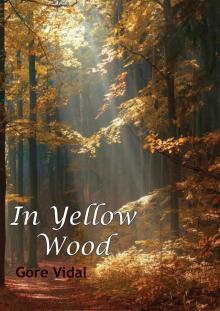 In a Yellow Wood
In a Yellow Wood Julian
Julian Hollywood
Hollywood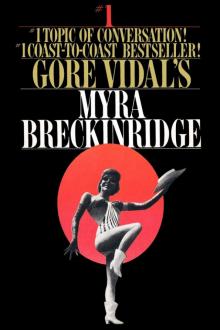 Myra Breckinridge
Myra Breckinridge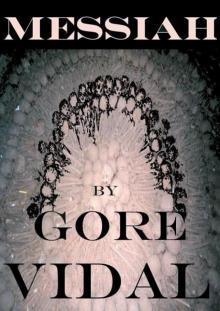 Messiah
Messiah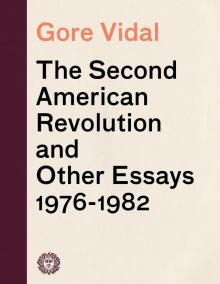 The Second American Revolution and Other Essays 1976--1982
The Second American Revolution and Other Essays 1976--1982 Homage to Daniel Shays
Homage to Daniel Shays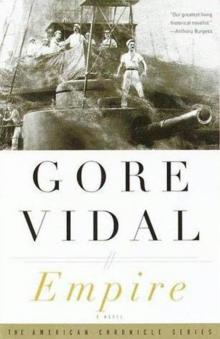 Empire
Empire Thieves Fall Out
Thieves Fall Out 1876
1876 The City and the Pillar
The City and the Pillar The Golden Age
The Golden Age At Home
At Home